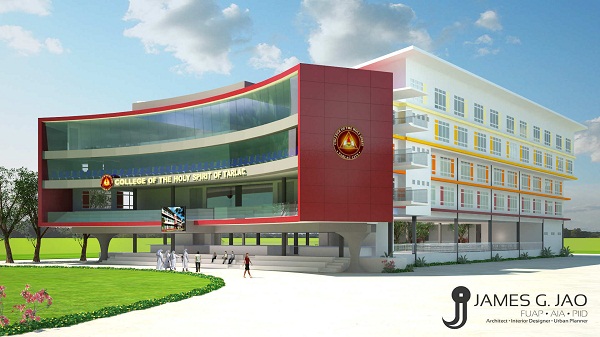With the Philippines facing possibilities of more intense typhoons, changes in rainfall patterns and rising temperatures, it is evident that the country is affected by worldwide climate change. Aware of this, some architects commit to implementing green architecture in their projects with sustainable materials specifications and using environment-friendly designs.
Early last year, Architect James Jao, an advocate and pioneer of eco-architecture and sustainable development in the Philippines, won the design bid for the construction of the academic building of the College of the Holy Spirit (CHS) in Tarlac. His environment-friendly architectural design and spatial planning, which coincided with the school’s thrust of Caring for Mother Earth, bested four other contenders.
“Turning the academic building into an eco-school building wasn’t really part of the plan. However, when Architect Jao presented his design, we realized that it reflects the thrust of our congregation – that all our apostolate wherever we are, may it be schools or hospitals, we would integrate the care for Mother Earth,” said Sister Teresita Artita, SSpS, Community Leader at College of the Holy Spirit – Tarlac.
The bold and cantilevered structure of the front façade created a very modern architecture. The graceful curve of the façade is the “big gesture” of the building, as if embracing and providing cradle for the students using the building and thus, reaching out to connect to the existing main building in design morphology. The floor to ceiling glass façade at the library and auditorium is another bold statement to connect to the students with the panoramic view overlooking and in conversation with the acacia tree at the quadrangle.
The significance of the school’s orientation played a very important role since the short sides of the structure faces the east and the west so there is hardly any sunlight transmitted into the classrooms. However, to further minimize the heat from the afternoon sun, Architect Jao used LOW-E (Low Emissivity) glass curve façade.

Primarily, the building envelop was built with THERMAWALL technology. The exterior walls are insulated to keep off the heat gain from the sun from entering the structure and provide a more comfortable indoor temperature. THERMAWALL technology uses HardieFlex® 6mm on the exterior with one-inch polystyrene insulation and another HardieFlex® 4.5mm panel on the interior to keep the heat from penetrating the walls. Passive cooling and cross-ventilation helped a lot in circulating the fresh air. The atrium and the high ceilings at the ground floor area became an avenue for natural ventilation to flow freely. The open hallway directly into the second floor bleachers served as the breezeway. The additional roller shades also added to the reduction of the Central Luzon heat.
“I want the students to experience the paradigm of learning in an eco-school building and contributing to a more sustainable development. They should be proud of this because they are consuming less energy and reducing their carbon footprint,” said Architect Jao.
Architect Jao has been an avid user of HardieFlex® since 2008 and he has been incorporating it in all of his eco-friendly designs. Because he uses THERMAWALL technology, HardieFlex® is a mainstay on his architecture, and he believes it is perfect for green architects like him.
Pioneered and manufactured by James Hardie, HardieFlex® fiber cement boards are made to be cost-efficient, durable, and eco-friendly. Made from unbleached pine wood pulp from sustainable plantation timber, ordinary Portland cement, sand, ordinary water and small amounts of additives, HardieFlex® does not contain asbestos and is low in Volatile Organic Compounds (VOCs). It is resistant to fire, termites, moisture damage, impact and rotting, thus lasts longer and hardly needs any maintenance (when installed and maintained correctly).
“I’ve been using HardieFlex® in my projects since 2008 and I have no plans of stopping. I’m happy and it meets my expectations. At the end of the day, as long as I am happy and the clients are happy, then I’ll never replace it,” said Architect Jao.

